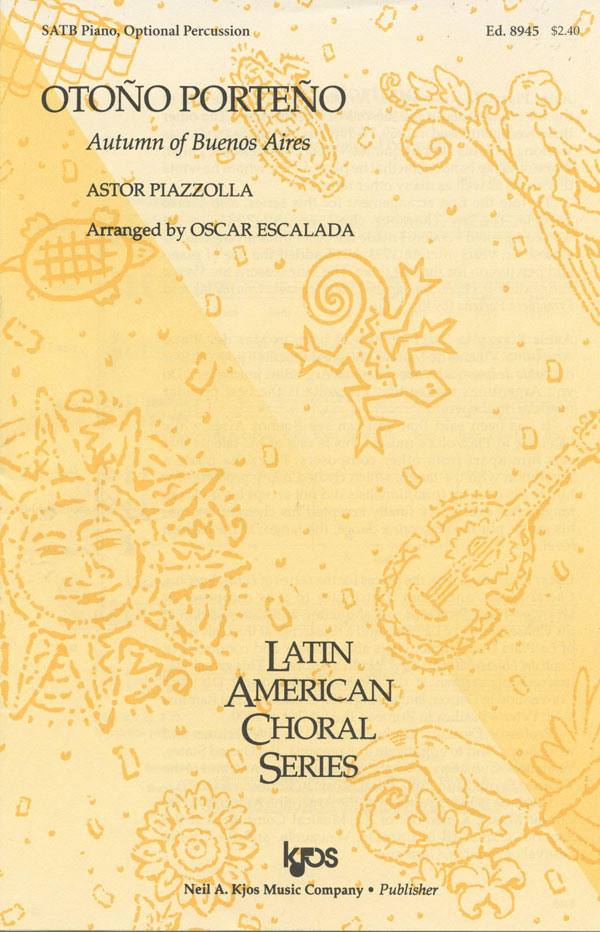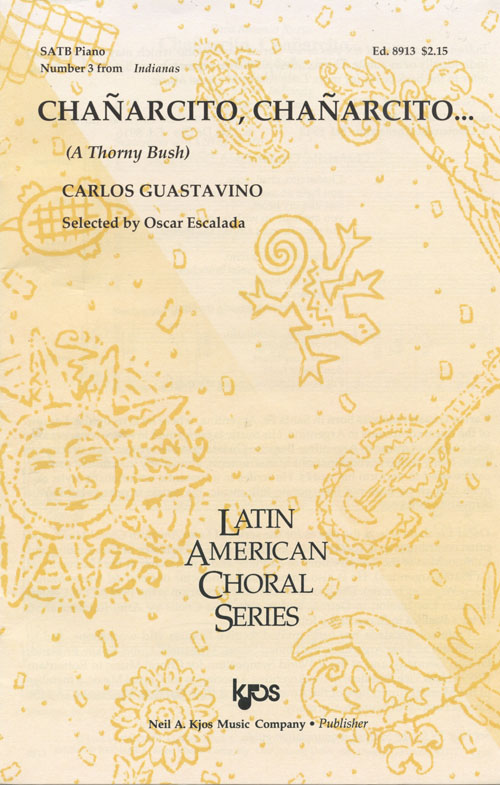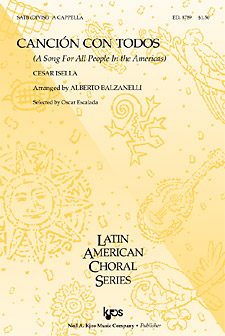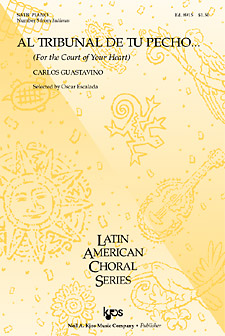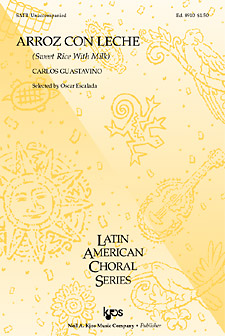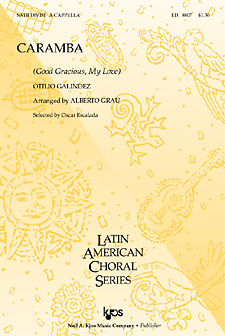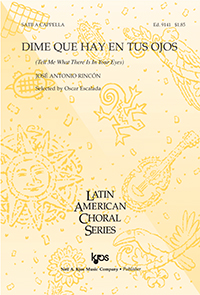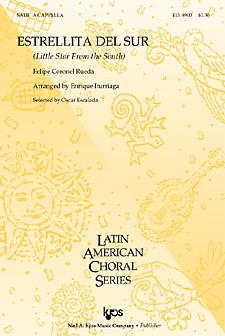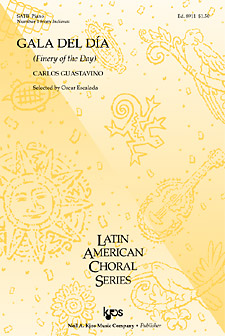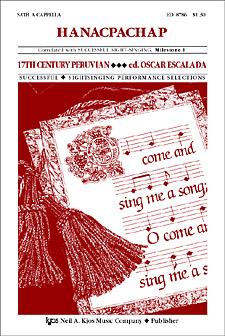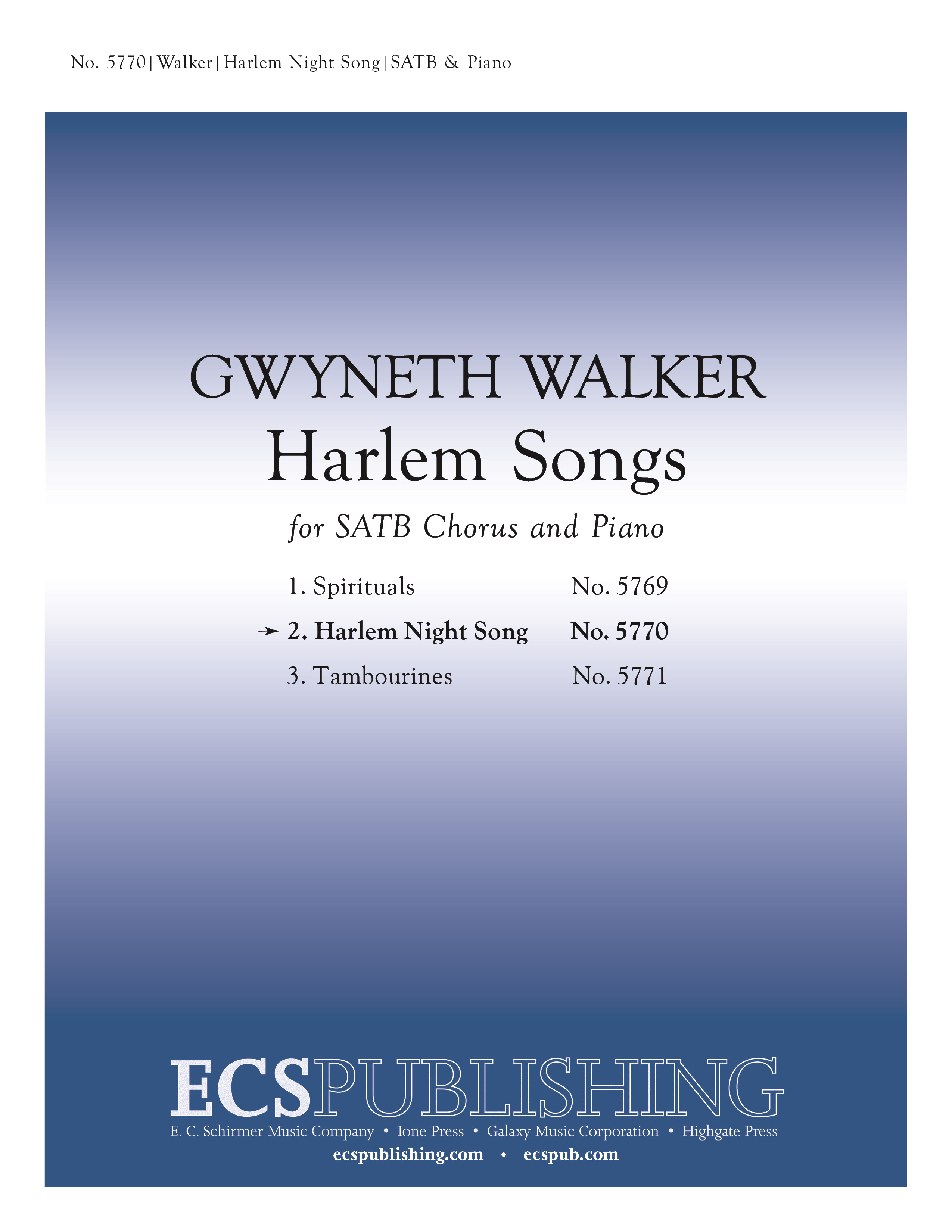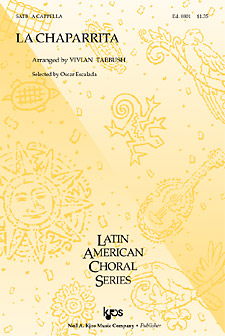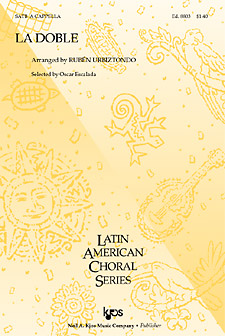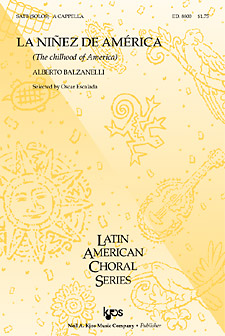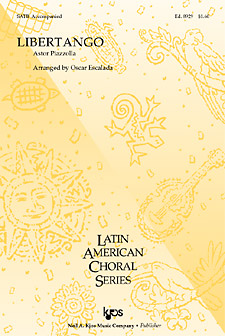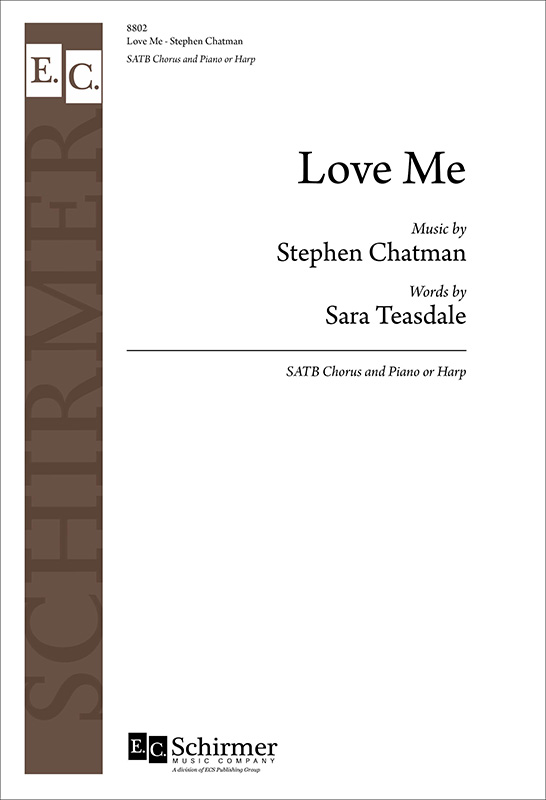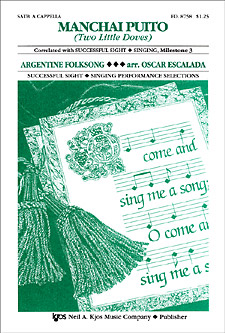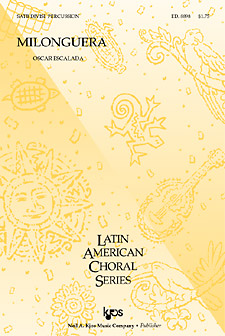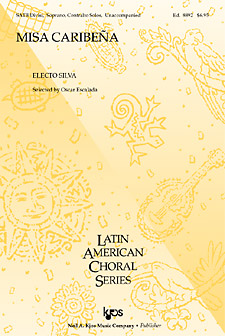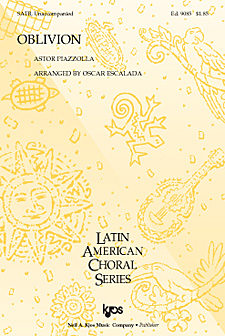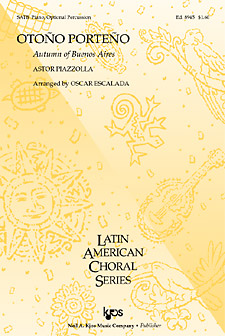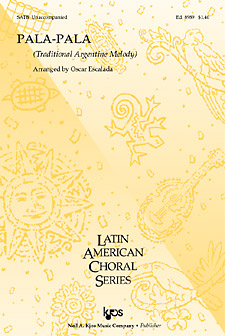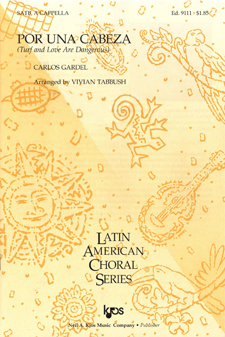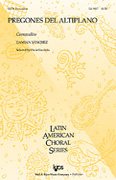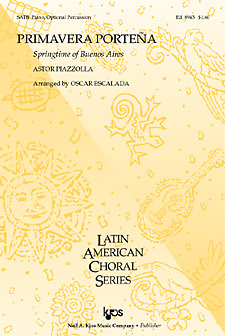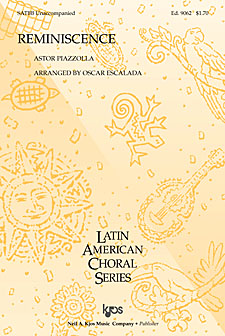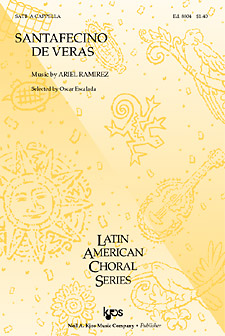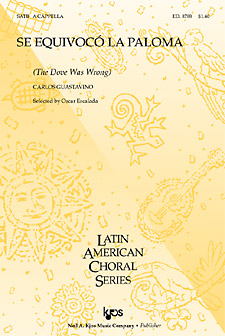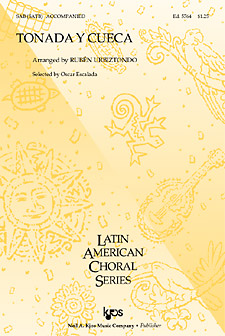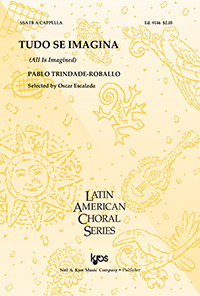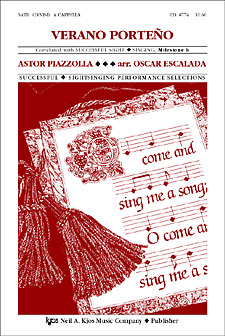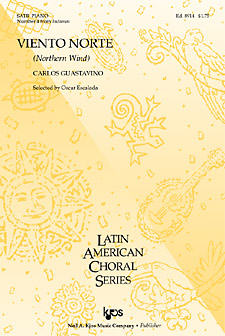In Celebration of the Human Voice - The Essential Musical Instrument
Home | Doo Wop | Barbershop | World | Contemporary | Christian | Vocal Jazz | Choral | Christmas | Instructional | Arrangements
Classical | Opera | Musicals | Personality | Young Singers | Disney | Videos | Songs | The Artists

Sheet Music Series
All | Barbershop | Choral | Choral Youth | Christian | Contemporary | Gospel | Musicals | Vocal Jazz | World | Male | Female | Christmas
Latin American Choral Series
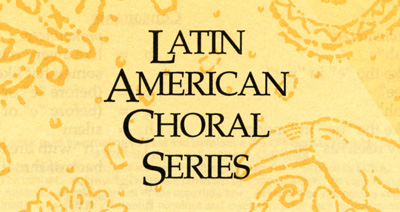
The Latin American Choral Series brings the exciting sounds of Latin America to choirs throughout the world. Selected by Oscar Escalada, the series includes a tremendous variety of styles ranging from the first polyphonic music composed in the New World, to traditional folksongs, tantalizing tangos, love songs, original compositions, and a mass.
All | SAB | SATB | SATB divisi | SSA | SSAA | SSATB
Series Collections
SATB
Review: It has been said that you can see Buenos Aires while listening to Astor Piazzolla's music. This is one of his talents that sets him apart from other composers. Piazzolla made a revolution with the tango, which created many problems for him in his country (traditionalists did not accept his music as tango). But everybody finally accepted his changes because his music put the Argentine dance, the tango, at the highest level. Gentle tango rhythms and modern harmonies infuse these folk-like tunes.
Songlist: Verano Porteno, Libertango, Primavera Poertena, Invierno Poerteno, Otono Porteno, Reminiscense
Review: Carlos Guastavino writes in a romantic-nationalistic style, and even though he does not incorporate folk music, his music is permeated by the Argentine influence. These intriguing pieces can be performed individually or as a suite.
Songlist: Gala del Dia, Quien Fuera Como el Jazmin, Chanarcito, Chanarcito, Viento Norte, Al Tribunal de Tu Pecho, Una de Dos
Review: A wonderful collection of contemporary Latin American choral music selected by noted Argintian conductor and composer Oscar Escalada. "La Chaparrita " is a brisk Venezuelan folk melody and is fun to sing and includes the vocal imitation of a typical pattern played on a "cuarto". "Candomble", from Uruguay, is written in a rhythm very close to the tango and the habanera. "La Ninez De America" is based on a poem of Argentinian poet Alberto del Carril and is inspired by the Incas. "Cancion Con Todos " is a two-part song based on two different rhythms. The first part is calm and recognizes each area of the Americas with characteristic elements such as copper for Chile, sun for Peru etc. The second part is rhythmic and exultant with the hope of bringing all the peoples of Latin America to sing together!
Songlist: La Chaparrita, Candomble, Cancion Con Todos, Se Equivoco La Paloma (The Dove Was Wrong), La Ninez De America
Individual Folios
SATB
Displaying 1-34 of 34 items.
Arroz Con Leche is based on a melody that Carlos Guastavino learned from his mother. It is a traditional children's round which is very popular in South America. A few small differences in the words occur in some countries. For instance, in Venezuela it is known as "rice with coconut" instead of with milk.
Caramba (Good Gracious, My Love) is a serenade from Venezuela. The roots of this style come from a Spanish tradition started around the Colonial time when the Spanish came to the Americas (16th-18th centuries). The serenade continued to be quite popular at the beginning of the 20th century. Typically, a young lady, just inside a window of her home, is serenaded by her lover. Fortunately, this is still practiced in some cities where life remains calm!
Arranger: Galindez
Chanarcito, Chanarcito (A Thorny Bush) is No. 3 of the Indianas suite by Carlos Guastavino, which may be performed individually or as a suite. Carlos Guastavino writes in a romantic-nationalistic style, and even though he does not incorporate folk music, his music is permeated by the Argentine influence.
Lima, the capital of Peru, was the most important cultural and political Spanish center from the Colonial times in the Americas until almost 1810, when the independence movements began in South America. The waltz originated in Europe around 1800 and was brought to the New World. Because the waltz rhythm became so popular in Peru, it has become known as the Peruvian waltz.
Arranger: Enrique Iturriaga
Gala del Dia (Finery of the Day) is No. 1 of the Indianas suite by Carlos Guastavino, which may be performed individually or as a suite. Carlos Guastavino writes in a romantic-nationalistic style, and even though he does not incorporate folk music, his music is permeated by the Argentine influence.
Harlem Night Song is infused with the language of blues: mixed major and minor tonalities, a gentle tempo, humming. The music is also nocturnal and atmospheric. The chorus sings "I love you", as if calling back and forth across the Harlem rooftops. A change of pace follows in the middle of the piece: "Down in the street, a band is playing..." Scat singing, percussive vocal effects and random patterns of "I love you" bring this work to a close. c. 3:15
Composer: Gwyneth Walker
It has been said that you can see Buenos Aires while listening to Astor Piazzolla's music. This is one of his talents that sets him apart from other composers. Piazzolla made a revolution with the tango, which created many problems for him in his country (traditionalists did not accept his music as tango). But everybody finally accepted his changes because his music put the Argentine dance, the tango, at the highest level.
Arranger: Oscar Escalada | Composer: Astor Piazzolla
The Golpe and the Joropo are typical folk dances of Venezuela and La Chaparrita is representative of the Golpe. Both Venezuelan dances are strongly rhythmical - while the female dancer waves her long, ample skirt, the male dancer keeps the beat in a clog dance.
Arranger: Vivian Tabbush | Composer: Oscar Escalada
A chacarera is a very joyful dance from the Province of Santiago del Estero (northwestern part of Argentina). Separate couples dance with their hands up, making "castanets" with their fingers. Between the first and second verses and again between the second and third verses, there is an instrumental interlude called vuelta, which means "round." At this time the dancers make a round in a circle and then back to their original places.
Arranger: Ruben Urbiztondo
The lyrics in La Ninez de America (The Childhood of America) are from a poem written by Bonifacio del Carril, an Argentinean poet who lived 1911-1994. Alberto Balzanelli took the idea for his composition from the music of the Incas, once one of the biggest empires in South America.
Arranger: Alberto Balzanelli | Composer: Oscar Escalada
It has been said that you can see Buenos Aires while listening to Astor Piazzolla's music. This is one of his talents that sets him apart from other composers. Piazzolla made a revolution with the tango, which created many problems for him in his country (traditionalists did not accept his music as tango). But everybody finally accepted his changes because his music put the Argentine dance, the tango, at the highest level.
Arranger: Oscar Escalada | Composer: Astor Piazzolla
Stephen Chatman's setting of Sara Teasdale's whimsical poem pertaining to a brown-thrush, April, love and kisses, emulates the meaning, strict rhythm, rhyme and strophic structure of the text. The soft rolled chords of the harp-like piano accompaniment highlight the lilting 6/8-meter, folk-like melody, and consistent homophonic choral texture. The repetitive lines, "Love me, love me, love me!", and "kiss me, kiss me, kiss me!", inspire the musical refrains. One of a set of six of Teasdale's love songs. Duration: 1:45
Composer: Stephen Chatman
Manchai Puito ( Two Little Doves) is a quichua (Indian) folksong from the rural part of Argentina near the Andes mountains. It is somewhat like the gaucho folksongs. The gauchos were of mixed Spanish and Indian heritage. They worked as cattle herders and are still celebrated by stories and songs because they were the heroes of the Pampas, the grassy plains around Buenos Aires. Gauchos were very honest and independent men. Like the cowboys of North America, a gaucho would sing to keep himself company as he worked alone on the plains. He would wear a fringed poncho, bombachas (baggy pants), a belt ornamented with silver coins, leather boots, and spurs.
Arranger: Oscar Escalada
Milonguera comes from the word milonga, which is a rhythm very close to the tango. The area of the milonga is Buenos Aires, Argentina. Oscar Escalda has built this exuberant work on a rhythmic pattern and its variations. The words are phenomes (nonsense words) created to get just the right effect with the rhythms.
Arranger: Oscar Escalada
The malambo is an Argentinean gaucho dance. It is performed only by men. The gauchos were of mixed Spanish and Indian heritage. They worked as cattle herders and are still celebrated by stories and songs because they were the heroes of the Pampas, the grassy plains around Buenos Aires. Gauchos were very honest and independent men. The two dancers perform a kind of fight: the first dancer "draws" a figure with his feet that must be repeated by the second one. When it is the second dancer's turn, he will draw another figure which must be duplicated by the first dancer. The figures are called mudanzas. The dance is over when one of the dancers cannot repeat the drawing of the other or cannot think of a new drawing. Also arranged for SSAA A Cappella
Arranger: Oscar Escalada
The title comes from the Latin oblivio/oblivium meaning "to forget," or better, "the condition of being forgotten, unknown." Astor Piazzolla's (Argentinian) music, originally written for instrumental ensemble, perfectly depicts this rather melancholy mood. Using carefully selected nonsense syllables, this skilled arranger has given advanced high school, college, and community choirs the opportunity to include this much-loved music in their performances. Choirs will love performing (and rehearsing!) this one.
Composer: Astor Piazzolla
It has been said that you can see Buenos Aires while listening to Astor Piazzolla's music. This is one of his talents that sets him apart from other composers. Piazzolla made a revolution with the tango, which created many problems for him in his country (traditionalists did not accept his music as tango). But everybody finally accepted his changes because his music put the Argentine dance, the tango, at the highest level.
Arranger: Oscar Escalada | Composer: Astor Piazzolla
Pala-pala (Raven) is a joyful song that is most fun when the singers (or dancers) make movements to fit the words, including pala-pala (raven), chuna (wading bird), and ampatu (toad). For instance, for the raven, dancers would move their arms and heads to imitate the wings of the raven.
Arranger: Oscar Escalada
Singer, songwriter and actor Carlos Gardel was born in France, but moved to Argentina at age 2. He was instrumental in popularizing the Argentine tango and rose to legendary fame in the late 1920's and early 1930's in Argentina and throughout Latinå America. Tragically, Gardel ded in 1935 in an airplane crash in Medellin, Colombia, in which his friend and lyricist Alfredo Le Pera also was killed. It is well known that Gardel was a horse racing amateur, and so it is not unusual that in his compositions he frequently refereed to jockeys and horses. The Argentine tango "Por Una Cabeza" (By Just One Head) was composed for Gardel's last film, Tango Bar (1935), and was used more recently in the American film Scent of a Woman (1992) starring Al Pacino. In this tango, love and women are compared to the dangerous chance of a horse race, where luck is often elusive. Hence, the sub-title "Turf and Love are Dangerous."
Arranger: Vivian Tabbush
Pregones del Altiplano (common cries from the Andean mesas) uses the carnavalito rhythm of a very common dance in an area called Altiplano. The Altiplano is in the northern part of Argentina and Bolivia, south of Peru, and north of Chile. It has recently been designated Patrinoio de la Humanidad because of its tradition and aborigine heritage.
Arranger: Oscar Escalada
It has been said that you can see Buenos Aires while listening to Astor Piazzolla's music. This is one of his talents that sets him apart from other composers. Piazzolla made a revolution with the tango, which created many problems for him in his country (traditionalists did not accept his music as tango). But everybody finally accepted his changes because his music put the Argentine dance, the tango, at the highest level.
Arranger: Oscar Escalada | Composer: Astor Piazzolla
Quien Fuera Como El Jazmin (Who Could Be Like the Jasmine) is No. 2 of the Indianas suite by Carlos Guastavino, which may be performed individually or as a suite. Carlos Guastavino writes in a romantic-nationalistic style, and even though he does not incorporate folk music, his music is permeated by the Argentine influence.
Gentle tango rhythms and modern harmonies infuse this folk-like tune. Sopranos carry the melody while Basses emulate rich pizzicatos, providing a deliberate, forward motion. Altos and Tenors fill out the texture, evoking sounds of bowed strings, the bandoneon, and the guitar. Lyrics are simple, easy to learn syllables; rhythms are straightforward, with a clear pulse. A great choice for introducing your choir to Latin American music!
Arranger: Oscar Escalada
Santafecino de versa is a chamame, a people's joyful dance from the eastern part of Argentina, an area called Litoral. The dancers put their cheeks together, looking at the same side. They take each other's hands extended ahead, and they dance together with an up and down movement, as if they were jumping. Sometimes they like to shout in a very high tune, which called sapucay, a Guarani language word.
Arranger: Oscar Escalada
Rafael Alberti is one of the great Spanish poets of the 20th Century. A few years after publishing the poem, Se equivoco la paloma (The Dove Was Wrong), Alberti was visited by a young Argentine composer who asked for permission to use the poem in a song. Alberti had never thought that his poem would become such a great success as it has. The young composer was indeed Carlos Guastavino. The song is a wonderful blend between the lyrics and the music. Guastavino musically describes the great tenderness of the dove that missed the way, but leaves to your imagination any kind of interpretation that you would like to make of this beautiful poem.
Arranger: Carlos Guastavino | Composer: Oscar Escalada
Tonada is a slow piece and is usually used in love songs, just as it is used in this case. Cueca is a very rhythmic and joyful dance. Both of these pieces are from the Andes area, in a region called "Cuyo," specifically from the Province of Mendoza in the western part of Argentina.
Arranger: Ruben Urbiztondo
Una de Dos (One Or the Other) is No. 6 of the Indianas suite by Carlos Guastavino, which may be performed individually or as a suite. Carlos Guastavino writes in a romantic-nationalistic style, and even though he does not incorporate folk music, his music is permeated by the Argentine influence.
It has been said that you can see Buenos Aires while listening to Astor Piazzolla's music. This is one of his talents that sets him apart from other composers. Piazzolla made a revolution with the tango, which created many problems for him in his country (traditionalists did not accept his music as tango). But everybody finally accepted his changes because his music put the Argentine dance, the tango, at the highest level.
Arranger: Oscar Escalada | Composer: Astor Piazzolla
Viento Norte (Northern Wind) is No. 4 of the Indianas suite by Carlos Guastavino, which may be performed individually or as a suite. Carlos Guastavino writes in a romantic-nationalistic style, and even though he does not incorporate folk music, his music is permeated by the Argentine influence.
![]() Vocal Harmony Arrangements - Home
Vocal Harmony Arrangements - Home
Christian | Gospel | Standards | Musicals | Specialty | World | Barbershop | Contemporary | Vocal Jazz | Choral | Christmas
Mixed Voices | Female | Male | 8 Parts | 6 Parts | 5 Parts | 3 Parts | 2 Parts | Medleys | Solo | Folio Series | New Releases
Select a Category |
Want to Sing? - Find a Chorus Near You
List of Choruses by State | List of Choruses by City

